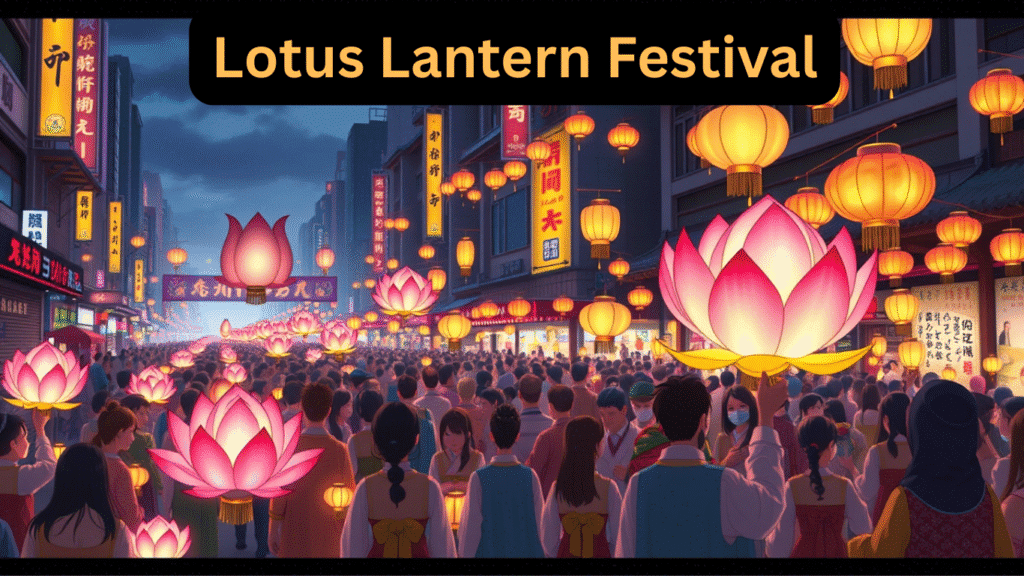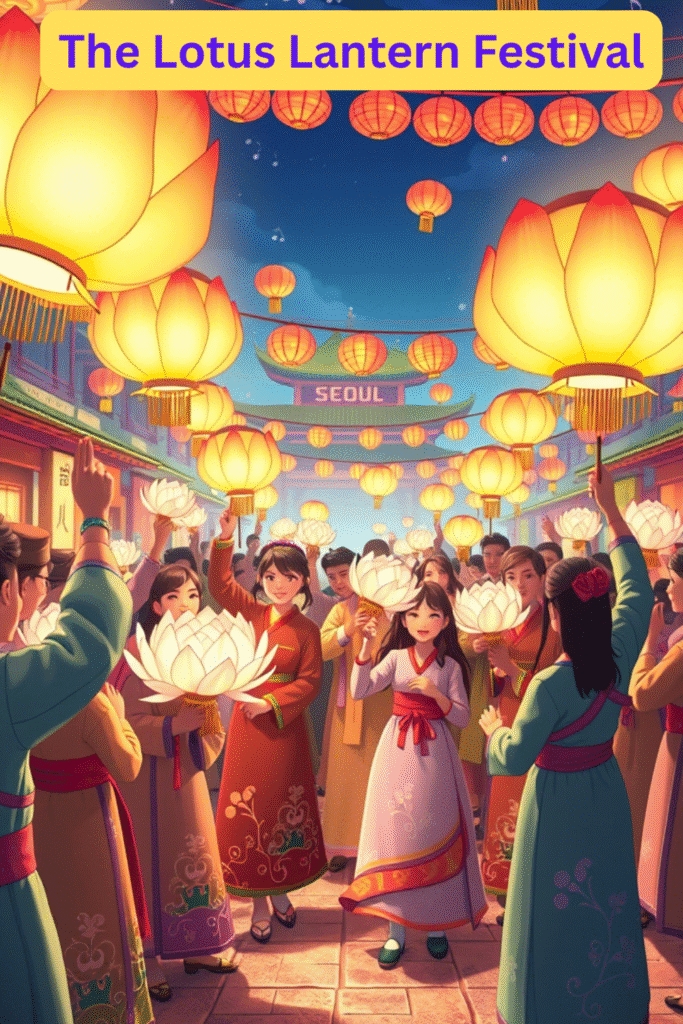
Every year, thousands of people gather in downtown Seoul to celebrate Yeon Deung Hoe , also known as the Lotus Lantern Festival . This vibrant festival is a beautiful blend of Buddhist traditions and Korean culture. Participants, many dressed in traditional Hanbok clothing, carry colorful lotus lanterns through the streets. The festival began as a religious celebration rooted in Buddhism but has now grown into a major cultural event that attracts people from all over the world. For Indian aspirants preparing for competitive exams, understanding this festival provides valuable insights into Buddhism’s global influence and its connection to Korean culture.
Table of Contents
What is the Lotus Lantern Festival?
The Lotus Lantern Festival, or Yeon Deung Hoe , is one of Korea’s most important cultural events. It takes place every year to celebrate Buddha’s Birthday , which falls on the eighth day of the fourth month in the lunar calendar. The festival is named after the lotus flower , a symbol of purity and enlightenment in Buddhism.
During the festival, participants carry lanterns shaped like lotus flowers, animals, and other designs. These lanterns are made of paper and bamboo and come in various colors, each representing different meanings:
- White : Purity and peace
- Red : Love and compassion
- Yellow : Wisdom and enlightenment
The streets of Seoul light up with thousands of lanterns, creating a magical atmosphere. People dressed in traditional Hanbok clothing add to the cultural richness of the event. Traditional music, dance performances, and food stalls make the festival a complete celebration of Korean heritage.
Key points for exams:
- The Lotus Lantern Festival celebrates Buddha’s Birthday.
- Lanterns symbolize purity, compassion, and enlightenment.
- It is both a religious and cultural event.
For more insightful articles and up-to-date current affairs, feel free to explore our website through this link.
History of the Lotus Lantern Festival
The origins of the Lotus Lantern Festival date back over 1,200 years to the Silla Dynasty (57 BCE–935 CE). During this time, Buddhism was the state religion, and lantern processions were held to honor the Buddha. The tradition continued through the Goryeo Dynasty (918–1392) and the Joseon Dynasty (1392–1897), though it faced challenges when Confucianism became dominant in Korea.
Despite periods of decline, the festival survived and evolved. In modern times, it has become a symbol of cultural pride and unity. Today, the festival attracts not only Buddhists but also tourists, families, and students who want to experience Korean traditions.
Important historical facts:
- The festival began during the Silla Dynasty over 1,200 years ago.
- It survived challenges during the Joseon Dynasty when Confucianism was dominant.
- It is now a global cultural event celebrated by people of all backgrounds.
To explore the rich heritage of Punjab, including its history, culture, and traditions, click here for detailed insights and valuable resources tailored for competitive exam preparation.
Significance of the Lotus Lantern Festival
The Lotus Lantern Festival is more than just a religious event; it is a celebration of cultural unity and global harmony . Here are some reasons why it is significant:
- Promoting Peace and Compassion : The festival emphasizes values like kindness, understanding, and unity. These are universal principles that resonate with people of all religions and cultures.
- Preserving Korean Traditions : By showcasing traditional clothing, music, and lantern-making techniques, the festival helps preserve Korea’s rich cultural heritage.
- Encouraging Community Participation : Thousands of volunteers help organize the festival, and many participants join workshops to learn how to make lanterns. This fosters a sense of community spirit.
- Tourism and Economy : The festival boosts tourism in Seoul and supports local businesses. Restaurants, hotels, and shops benefit from the influx of visitors.
For exams, note these points:
- The festival promotes peace, compassion, and unity.
- It preserves Korean traditions and encourages community participation.
- It contributes to tourism and the local economy.
To master Punjabi grammar with easy-to-understand rules and practice exercises, click here for our comprehensive resources designed to enhance your language skills.

How Buddhism Shaped Korean Culture
Buddhism has had a profound impact on Korean society throughout history. When Buddhism arrived in Korea in the 4th century CE, it quickly became a major influence on art, architecture, and philosophy. Temples were built across the country, and Buddhist monks played important roles in education and governance.
Some examples of Buddhism’s influence include:
- Architecture : Famous temples like Bulguksa and Seokguram Grotto are UNESCO World Heritage Sites.
- Art : Buddhist paintings and sculptures are treasured works of Korean art.
- Philosophy : Buddhist ideas about compassion and mindfulness shaped Korean ethics and values.
Even today, Buddhism remains an important part of Korean identity. Events like the Lotus Lantern Festival remind people of their shared heritage and spiritual roots.
Key points for exams:
- Buddhism arrived in Korea in the 4th century CE.
- It influenced Korean art, architecture, and philosophy.
- Temples like Bulguksa and Seokguram Grotto are UNESCO World Heritage Sites.
To strengthen your English grammar skills with comprehensive explanations and practice exercises tailored for competitive exams, click here for our expert-curated resources.
Why the Lotus Lantern Festival Matters Globally
The Lotus Lantern Festival is not just a Korean event; it has global significance. As one of the largest celebrations of Buddhism outside India, it highlights the religion’s universal appeal. People from different countries and backgrounds come together to participate, promoting cross-cultural understanding.
Moreover, the festival’s themes of peace, harmony, and environmental awareness align with global goals. For example, the use of eco-friendly lanterns reflects the importance of sustainability. The festival also inspires similar events in other countries, spreading its message of unity and compassion.
Exam-worthy facts:
- The festival promotes cross-cultural understanding.
- It emphasizes global themes like peace, harmony, and sustainability.
- It inspires similar events in other countries.
To enhance your English vocabulary with the latest words frequently appearing in competitive exams, click here for exclusive resources and curated lists designed to boost your preparation.
The Origins of Buddhism
Buddhism was founded by Siddhartha Gautama , also known as the Buddha, in the 6th century BCE in India. He taught the importance of overcoming suffering and achieving enlightenment through the Four Noble Truths and the Eightfold Path . These teachings focus on living a life of morality, meditation, and wisdom.
From India, Buddhism spread to other parts of Asia, including Korea, China, Japan, and Southeast Asia. It traveled along ancient trade routes like the Silk Road and was supported by rulers such as Emperor Ashoka, who sent missionaries to spread Buddhist teachings far and wide. In Korea, Buddhism became a central part of the culture and influenced art, architecture, and philosophy.
For competitive exams, remember these key facts:
- Buddhism originated in India in the 6th century BCE.
- It was spread globally by missionaries and traders.
- The Four Noble Truths and Eightfold Path are its core teachings.
The Lotus Lantern Festival is a shining example of how ancient traditions can thrive in the modern world. Rooted in Buddhism, it has evolved into a cultural celebration that brings people together. For Indian aspirants preparing for competitive exams, understanding this festival offers valuable insights into the global spread of Buddhism and its influence on Korean culture.
By studying the history and significance of the Lotus Lantern Festival, you can appreciate how cultural events like this promote unity, preserve traditions, and inspire positive change. Whether you’re learning about Buddhism’s origins, its journey to Korea, or its role in contemporary society, the festival serves as a powerful reminder of the enduring legacy of one of the world’s oldest religions.
